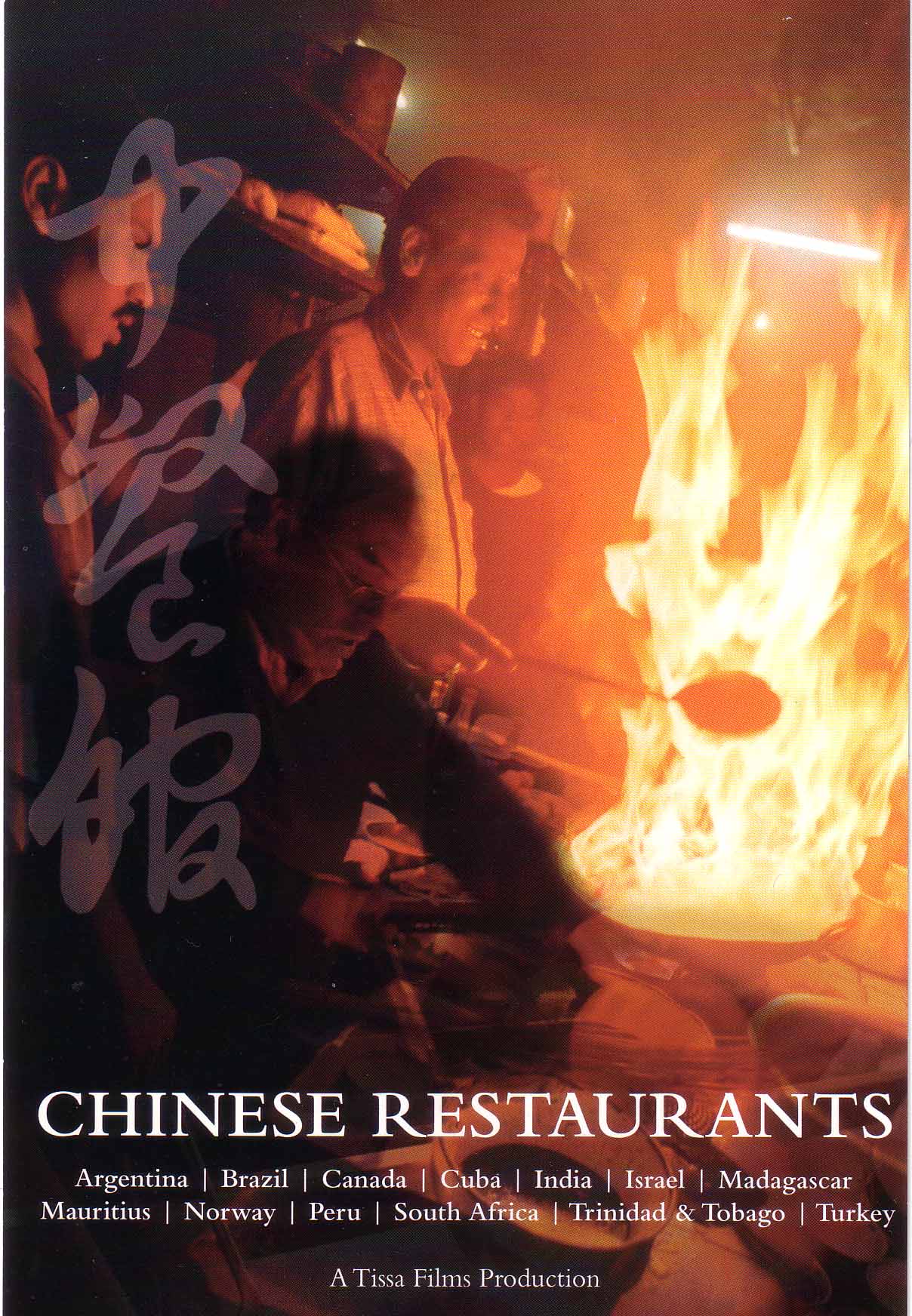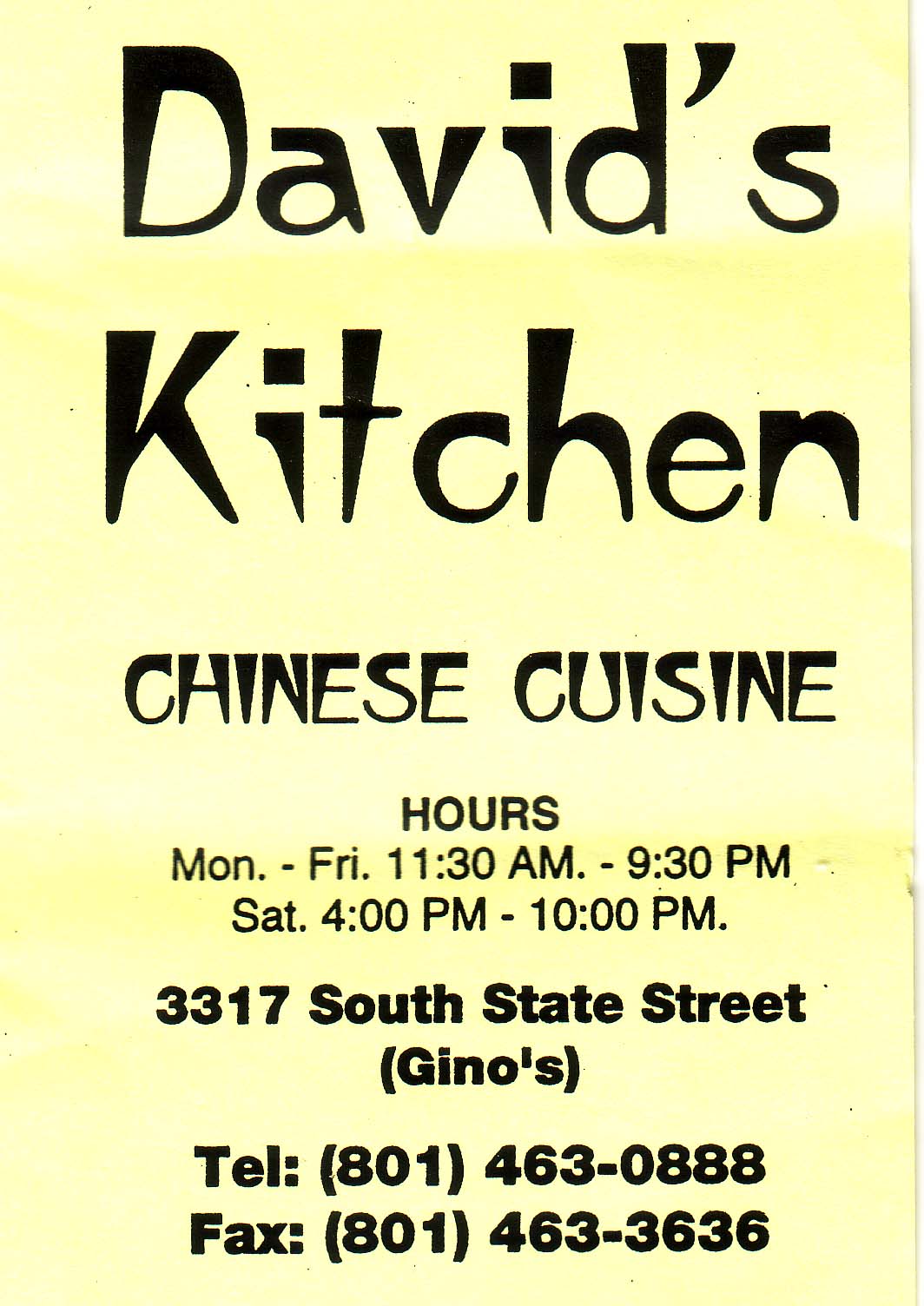
| What is Flavor and Fortune? |
| How do I subscribe? |
| How do I get past issues? |
| How do I advertise? |
| How do I contact the editor? |
Read 12915615 times
Connect me to:
| Home |
| Articles |
| Book reviews |
| Letters to the Editor |
| Newmans News and Notes |
| Recipes |
| Restaurant reviews |
| Article Index (all years, slow) |
| List of Article Years |
| Article Index (2025) |
| Article Index (last 2 years) |
| Things others say |
| Related Links |
| Log In... |
| Authors |
| Categories & Topics |
TOPICS: Chinese Restaurant documentaries; Grated cheese powder; Meyer lemons; Soybeans; Buddhism; Seasonal foods; Salt Lake City
| by Jacqueline M. Newman |
Newman's News and Notes
Summer Volume: 2005 Issue: 12(2) page(s): 27, 28, and 29
 CHINESE RESTAURANTS is a thirteen-part documentary series that offers interesting views of Chinese immigration and politics. Each is one view through one owner of a Chinese restaurant somewhere in the world. Conceived and directed by Cheuk Kwan, these are Tissa Films Production. They are colorful views, one each of a global Chinese citizen.
One film each is about a restauranteur in Argentina, Brazil, Canada, Cuba, India, Israel, Madagascar, Mauritius, Norway, Peru, South Africa, Trinidad & Tobago, and Turkey. Each film shows an exterior view of the restaurant, a little bit of its food, and lots about the interior mind of the person in focus, namely the owner-restauranteur. In their own way, these films tell about the Chinese diaspora using an individual who owns a family-rum restaurant. They look at their courage, struggles, bravado, and sometimes if they belong or not to the culture they have chosen to live in.
CHINESE RESTAURANTS is a thirteen-part documentary series that offers interesting views of Chinese immigration and politics. Each is one view through one owner of a Chinese restaurant somewhere in the world. Conceived and directed by Cheuk Kwan, these are Tissa Films Production. They are colorful views, one each of a global Chinese citizen.
One film each is about a restauranteur in Argentina, Brazil, Canada, Cuba, India, Israel, Madagascar, Mauritius, Norway, Peru, South Africa, Trinidad & Tobago, and Turkey. Each film shows an exterior view of the restaurant, a little bit of its food, and lots about the interior mind of the person in focus, namely the owner-restauranteur. In their own way, these films tell about the Chinese diaspora using an individual who owns a family-rum restaurant. They look at their courage, struggles, bravado, and sometimes if they belong or not to the culture they have chosen to live in.
These thirteen looks at the world one person at a time, are being shown around the world. Some, if not all, have been seen at the San Francisco International Asian Film Festival, the Hong Kong International Film Festival, the Museum of the Chinese in the America’s in New York City, and elsewhere. Want to know when and where you might catch one or more of these twenty minute made-for-television documentaries? Contact Mr. Kwan at ckwan@tissa.com or check with your local TV station.
Kwan, a Canadian, founded Asianadian, a magazine to promote Asian Canadian arts. In 1995, he ended a twenty-plus-year career in information technology, took a course at New York University about film making, and began this new part of his life. As a member of the Harmony Movement, a national non-profit organization dedicated to fostering harmony and diversity in Canada, he works with the UN and other non-governmental agencies to obtain equality for Chinese Canadians.
Kwan is both talented and committed. He is fluent in five languages, and did these documentaries on his own buck paying expenses for himself and a two-man crew. Together, they visited and filmed these thirteen restauranteurs, writing script, editing, etc. What we do not know is how the restauranteurs were selected, you can ask him that.
We saw but a few so far, such as the one about the spring roll king, Foo-Ching Chiang of Buenos Aires, Argentina. When in that country some years ago, we actually did visit his Casa China and we enjoyed eating there, but we are unsure if it was with the same ownership. We also ate at Luis Yong’s Chinese restaurant called San Joy Lao in Barrio China in Lima, Peru. However, when there, we did not know enough to see this Doc’s TV program, nor even a fraction of the thirty thousand chifa’s in Lima he speaks about in the film.
As MOCA and others show these segments, we do plan to see them all. There is much to learn from Kwan’s first foray featuring folk and film as sociological studies. Check them out; there is lots to learn about Chinese diaspora expectations, perceptions, successes, and even some of their food fantasies, or myths if you’d prefer that word.
GRATED CHEESE POWDER, is an ingredient found in some newer Chinese cookbooks from Hong Kong and Taiwan. Long have we been befuddled by this. Once or twice we even tried grated Parmesan cheese knowing it was not right, but not knowing what this 'grated cheese' was. Did know that was an idiotic substitution because of the way the powder was handled, but never could locate a person or book that could deal with out befuddlement. Now the puzzle has been solved.
 Grated cheese it is not, never mind that is its name in these books. A more ordinary thickener it is. The secret ingredient is none other than Bird’s Dessert Mix. Other newer items that confused for a while but common sense cleared our clouded glasses were mushroom powder and chicken granules. For the former, we simply cut up, then ground dried Chinese black mushrooms in a small coffee grinder we keep reserved for grinding spices. As to the chicken granules, one day it suddenly dawned that they meant powdered chicken bouillon and that was that. But the grated cheese powder was not so simple to figure out. That bit of cloudiness clarified when we saw a recipe using it and in the background of the picture was a can of the Bird’s dessert powder.
Grated cheese it is not, never mind that is its name in these books. A more ordinary thickener it is. The secret ingredient is none other than Bird’s Dessert Mix. Other newer items that confused for a while but common sense cleared our clouded glasses were mushroom powder and chicken granules. For the former, we simply cut up, then ground dried Chinese black mushrooms in a small coffee grinder we keep reserved for grinding spices. As to the chicken granules, one day it suddenly dawned that they meant powdered chicken bouillon and that was that. But the grated cheese powder was not so simple to figure out. That bit of cloudiness clarified when we saw a recipe using it and in the background of the picture was a can of the Bird’s dessert powder.
Should you ever need these ingredients, your puzzle is solved. For those that may never see them, don’t be disappointed, we offer two recipes at the end of this article.
MEYER LEMONS are indeed Chinese, their name not an Americanized spelling of a Chinese word. The Meyer lemon is named after the person who brought them from and planted them in the United States. They are a hybridized fruit. The suspicion is that they are a cross between a lemon and a mandarin. For those who have not yet seen one, do not look for a yellow fruit that is lemon-shaped. They are somewhat round, and yes, they are sweeter than most lemons in either country. The peel is also sweeter. Though it can be dried and used in place of tangerine peel, it is a poor substitute because the taste is different. What you need to know is that the Meyer lemon is juicier, so when selecting yours, pick the heaviest. We found the juice a pleasant substitute for vinegar in meat recipes, and an excellent addition to many bakery items popular for dim sum. To the best of our knowledge, they have not made their way into the common cuisines of China, but surely will soon.
SOYBEANS are not new to the United States, contrary to many queries about their recent arrival in local stores. Soybeans have roots in China, for several thousand years. They went to other Asian countries thereafter, came to the United States early in the 1800's, were a harvested crop in 1829. What interests many is that Argentina and the United States are now the largest producers of soybeans while China and other Asian countries are the largest per capita consumers. One of the best resources for information about soy foods can be had by contacting the Soyfoods Council. They are in Iowa, and can be reached by phone at 866-432-9814 or on the web at: www.thesoyfoodscouncil.com
BUDDHISM is related to Zen, because that is one of its Japanese names. A little history might help. When Buddhist beliefs came to China, they were reshaped Chinese-style. This belief system has no single god, and does have many deities. Many say that the most beloved of the gods was male in India but became female in China That was a few hundred years later, in the mid 1100's. This belief needed revival by the Song Dynasty, that is by 960 CE, and thereafter. Why did it need that, because Chinese Buddhism was recovering from the suppression of the 9th century. And when it did recover, it did so with Chinese ideas. Actually, only two schools of Buddhist thought recovered. One was the Chan school, known in Japan as the Zen school, and the other, the Pure Land teachings. Chan Buddhism is a Chinese form that has less emphasis on food and more on meditation and enlightenment. In Tibet, there is another form of this religion; it is called Lamaism. It is quite distinct, and it has more food strictures than does Chan Buddhism. This may be why there are very few Chinese Buddhist foods, but many Chinese Buddhists.
WHY SEASONAL FOODS? The Chinese believe that seasonal changes impact health. Winter foods were discussed in Favor and Fortune’s Volume 11(4) on page 31. Every season should be taken into consideration and thanks to many requests, here are foods for two more seasons. There are correct ones for each time of year. They compliment natural forces and replenish bodily needs. Many books discuss Chinese systems of eating with the seasons. Some call it ‘Echoing Nature’ others refer to it as the naturopathic system of restoration, replenishment, and reviving. Protecting self in season is appropriate behavior because weather fluctuates and food choices should, too. Keep in mind that many foods should not be eaten year round. A Chinese proverb says it best: On earth no feast lasts forever. Because the eyes are wide but the stomach narrow, it is appropriate to seasonally narrow food selections.
SPRING FOODS are such that they always eliminate or avoid including onions, uncooked scallions, cinnamon, star anise, and Sichuan peppers Spring wakes up the winter doldrums, and is a time to drink fruit juices. This is yang energy time so avoid all greasy and spicy foods including all that are deep fried. This is the time to supplement one’s liver. Eating sweet foods is the thing to do, and refraining from consuming sour ones is in order. Pea sprouts, Chinese wolfberry leaves, garland chrysanthemum leaves should be cooked and eaten often, while lamb should join the ‘what to avoid’ list.
SUMMER FOODS should also remain at a distance from the onion. Add chives to the list of things to avoid, and continue to avoid lamb. The summer season is also the time to refrain from eating the lychee and the longan, and many cold foods, most particularly congee and rice. This season is a time when accumulated dampness and heat are increasing, and it is the time the body needs more qi and more fluids, but not cold ones. Drink lots of liquid either hot or at room temperature.
Also, eat many berries and fruits, and lots of spinach, bitter melon, winter melon, and seaweed preparations. Continue to avoid fried and other greasy foods, and avoid all uncooked foods cold in nature. Persimmons, plums, tomatoes, and pineapple are good choices. So are vegetables including sweet potatoes, mung beans, water chestnuts, and winter melon. When feeling tired or without appetite, be particularly careful and do not eat fatty foods or spicy ones. Put job’s tears, lotus root, and laver in your dishes, and eat many mushrooms, straw mushrooms are particularly energy raising.

SALT LAKE CITY (SLC) Chinese food was a find by a reader. That makes for at least three places we know about to enjoy Chinese food in and near Salt Lake City. Two were previously touted. One reported in Volume 5(4) on pages 12 and 19 called Xiao Li on 307 West 200 South in Salt Lake City; the other is in a SLC suburb called Bountiful and called Mandarin restaurant at 348 E 900 N. It was written about in Volume 6(1) on page 12 and in volume 9(2) on page 27. A knowledgeable fellow, this reader, has graced our table many times. He now tells about David’s Kitchen, 3317 South State Street in Salt Lake City. Though they appeared in this column, for thisa web copy of Flavor and Fortune, see his comments in the Restaurant Reviews section of this website.
| Hasma, Wax Gourd, and Chicken |
|---|
1/2 pound wax gourd, peeled 3 ounces chicken breast, minced 1 teaspoon sugar 2 teaspoons chicken granules 1 teaspoon sesame oil 2 teaspoons ‘grated cheese powder’ 1 teaspoon Chinese wolfberries 2 Tablespoons snow frog ovaries (hasma), soaked for half hour in one-quarter cup of warm water, drained, then minced Preparation: 1.Steam the wax gourd for ten minutes, cool, then mince. 2. Bring four cups water to the boil, reduce heat to simmer, and add the minced vegetable and chicken breast, the sugar, chicken granules, sesame oil, cheese powder, and the wolfberries. Stir and simmer for five minutes, then add the snow frog ovaries and simmer and stir another three minutes, then serve. |
| Fish Rolls |
|---|
1/2 pound boneless and skinless single piece filet of sea or black bass 2 ounces enoki mushrooms 1 ounce bean spouts, heads and tails removed 1 teaspoon fermented rice 1 square fermented bean curd 1 teaspoon ‘grated cheese powder’ 1 teaspoon chicken granules 1 teaspoon minced fresh ginger 1 clove garlic, minced 2 teaspoons fermented black beans, rinsed and minced 1 teaspoon sesame oil ½ teaspoon ground white pepper 1 teaspoon corn oil Preparation: 1. Slice the fish parallel to the counter top into four equally thin slices; then cut each in half across the width so that there will be eight thin slices of fish. The technique is to keep the cleaver parallel to the counter top tilting its edge almost imperceptibly downward. The other hand should be absolutely flat pressing down on the fish filet. After making each slice, remove it before cutting the next one. 2. In a bowl, gently mix all the rest of the ingredients except the corn oil. Use that to grease a small plate that can go into a steamer. 3. Take a small portion (about one eighth) of the mushroom-bean sprout mixture and place it in the center of a fish slice. Roll the ends to the center, and putting the seam in the center, put it seam side down on the greased plate. Repeat filling the other seven slices of fish. 4. Steam over boiling water for seven minutes, remove and serve. |

Copyright © 1994-2025 by ISACC, all rights reserved
Address
3 Jefferson Ferry Drive
S. Setauket NY 11720